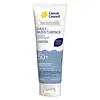What's inside
What's inside
 Key Ingredients
Key Ingredients

 Benefits
Benefits

 Concerns
Concerns

 Ingredients Side-by-side
Ingredients Side-by-side

Octocrylene 8%
UV AbsorberHomosalate 6%
Skin ConditioningButyl Methoxydibenzoylmethane 3%
UV AbsorberAcrylates/C10-30 Alkyl Acrylate Crosspolymer
Emulsion StabilisingAloe Barbadensis Leaf Juice
Skin ConditioningCarbomer
Emulsion StabilisingCetearyl Alcohol
EmollientDisodium EDTA
Tocopheryl Acetate
AntioxidantGlycerin
HumectantGlyceryl Stearate
EmollientHydrated Silica
AbrasiveHydroxyacetophenone
AntioxidantAlcohol Denat.
AntimicrobialIsopropyl Palmitate
EmollientPhenoxyethanol
PreservativePolyglyceryl-3 Diisostearate
EmulsifyingPotassium Cetyl Phosphate
EmulsifyingWater
Skin ConditioningPvp
Emulsion StabilisingTriethanolamine
BufferingXanthan Gum
EmulsifyingOctocrylene 8%, Homosalate 6%, Butyl Methoxydibenzoylmethane 3%, Acrylates/C10-30 Alkyl Acrylate Crosspolymer, Aloe Barbadensis Leaf Juice, Carbomer, Cetearyl Alcohol, Disodium EDTA, Tocopheryl Acetate, Glycerin, Glyceryl Stearate, Hydrated Silica, Hydroxyacetophenone, Alcohol Denat., Isopropyl Palmitate, Phenoxyethanol, Polyglyceryl-3 Diisostearate, Potassium Cetyl Phosphate, Water, Pvp, Triethanolamine, Xanthan Gum
4-Methylbenzylidene Camphor
UV AbsorberBis-Ethylhexyloxyphenol Methoxyphenyl Triazine
Skin ConditioningMethylene Bis-Benzotriazolyl Tetramethylbutylphenol
UV FilterZinc Oxide
Cosmetic Colorant1,2-Hexanediol
Skin ConditioningC12-15 Alkyl Benzoate
AntimicrobialAloe Barbadensis Leaf Juice
Skin ConditioningBHT
AntioxidantCalcium Stearate
Cosmetic ColorantCaprylyl Glycol
EmollientCopernicia Cerifera Wax
Decyl Glucoside
CleansingDisodium EDTA
Tocopheryl Acetate
AntioxidantGlyceryl Oleate
EmollientIsopropyl Palmitate
EmollientMagnesium Sulfate
PEG-30 Dipolyhydroxystearate
EmulsifyingPhenoxyethanol
PreservativePropylene Glycol
HumectantWater
Skin ConditioningTriacontanyl Pvp
HumectantXanthan Gum
Emulsifying4-Methylbenzylidene Camphor, Bis-Ethylhexyloxyphenol Methoxyphenyl Triazine, Methylene Bis-Benzotriazolyl Tetramethylbutylphenol, Zinc Oxide, 1,2-Hexanediol, C12-15 Alkyl Benzoate, Aloe Barbadensis Leaf Juice, BHT, Calcium Stearate, Caprylyl Glycol, Copernicia Cerifera Wax, Decyl Glucoside, Disodium EDTA, Tocopheryl Acetate, Glyceryl Oleate, Isopropyl Palmitate, Magnesium Sulfate, PEG-30 Dipolyhydroxystearate, Phenoxyethanol, Propylene Glycol, Water, Triacontanyl Pvp, Xanthan Gum
 Reviews
Reviews

Ingredients Explained
These ingredients are found in both products.
Ingredients higher up in an ingredient list are typically present in a larger amount.
Aloe Barbadensis Leaf Juice comes from leaves of the aloe plant. Aloe Barbadensis Leaf Juice is best known for helping to soothe sunburns. It is also anti-inflammatory, moisturizing, antiseptic, and can help heal wounds.
Aloe is packed with good stuff including Vitamins A, C, and E. These vitamins are antioxidants, which help fight free-radicals and the damage they may cause. Free-radicals are molecules that may damage your skin cells, such as pollution.
Aloe Barbadensis Leaf Juice also contains sugars. These sugars come in the form of monosaccharides and polysaccharides, folic acid, and choline. These sugars are able to help bind moisture to skin.
It also contains minerals such as calcium, 12 anthraquinones, fatty acids, amino acids, and Vitamin B12.
Learn more about Aloe Barbadensis Leaf JuiceDisodium EDTA plays a role in making products more stable by aiding other preservatives.
It is a chelating agent, meaning it neutralizes metal ions that may be found in a product.
Disodium EDTA is a salt of edetic acid and is found to be safe in cosmetic ingredients.
Learn more about Disodium EDTAIsopropyl Palmitate is a texture enhancer and emollient. It is an ester of isopropyl alcohol and palmitic acid.
Palmitates are emollients. Emollients help keep your skin soft and smooth by creating a barrier that traps moisture in.
When added to cosmetics, Isopropyl Palmitate creates a silky texture and improves spreadability.
Isopropyl Palmitate may not be fungal acne safe. It can worsen acne prone skin.
Learn more about Isopropyl PalmitatePhenoxyethanol is a preservative that has germicide, antimicrobial, and aromatic properties. Studies show that phenoxyethanol can prevent microbial growth. By itself, it has a scent that is similar to that of a rose.
It's often used in formulations along with Caprylyl Glycol to preserve the shelf life of products.
Tocopheryl Acetate is AKA Vitamin E. It is an antioxidant and protects your skin from free radicals. Free radicals damage the skin by breaking down collagen.
One study found using Tocopheryl Acetate with Vitamin C decreased the number of sunburned cells.
Tocopheryl Acetate is commonly found in both skincare and dietary supplements.
Learn more about Tocopheryl AcetateWater. It's the most common cosmetic ingredient of all. You'll usually see it at the top of ingredient lists, meaning that it makes up the largest part of the product.
So why is it so popular? Water most often acts as a solvent - this means that it helps dissolve other ingredients into the formulation.
You'll also recognize water as that liquid we all need to stay alive. If you see this, drink a glass of water. Stay hydrated!
Learn more about WaterXanthan gum is used as a stabilizer and thickener within cosmetic products. It helps give products a sticky, thick feeling - preventing them from being too runny.
On the technical side of things, xanthan gum is a polysaccharide - a combination consisting of multiple sugar molecules bonded together.
Xanthan gum is a pretty common and great ingredient. It is a natural, non-toxic, non-irritating ingredient that is also commonly used in food products.
Learn more about Xanthan Gum